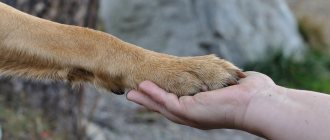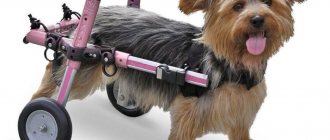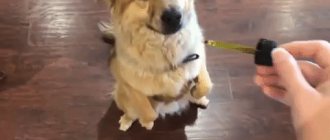The summer months are a difficult test for our pets. During this period, you should take care of your four-legged friend and protect him from overheating and sunstroke.
In hot summers, the scorching sun is especially dangerous, which is difficult for not only people, but also dogs. They try in every possible way to hide from him in cool, shady revenge. On especially hot days, dogs refuse to eat, drink a lot of water, and try to move less.
Overheating of a dog's body can lead to loss of consciousness and even death. To keep your pet safe, you should follow simple rules.
If the dog is hot in the apartment
Before leaving the apartment, leave the windows open; fresh air must come from the street.
Do not close the doors in the rooms. As the sun moves, the heat in the apartment will move from room to room. The dog will be better off if it can move around the house.
Curtain the curtains so the sun's rays will heat up the room less. But you shouldn’t abuse it and make it dark, the dog should see daylight.
Leave the doors to the bathroom and toilet open. Dogs love to lie on cool tiles. For extra cooling, wet a cloth and spread it on the floor.
If you have an air conditioner, set it to the optimal temperature by directing the air flow to the wall, not to the floor.
How to cool your pet
The easiest and most affordable way to quickly help your pet is water. It is important to remember that it should not be icy or even cold. A sudden change in temperature can cause vasospasm and cause even more harm.
Take water at room temperature or slightly cooler and generously wet your dog's belly and paws. You can wipe the face and ears with a damp towel. Place a cold towel on the head, but do not cover the dog completely, this will hinder heat transfer. In the apartment you can turn on the air conditioning, curtain the windows and ventilate the room well.
Make sure your dog has drinking water
On hot days, your dog will drink a lot. Monitor the amount of water in the bowl.
If your pet is left alone for a long time, pour water into two bowls.
The water should be clean and cool. Renew the water as often as possible.
Before your walk, be sure to take a bottle of water not only for yourself, but also for your dog.
If you're going on a trip, chill the water in the freezer and put a cooler in your bag to keep the water cooler longer.
Change your walking schedule
Try to walk your dog during hot weather, either early in the morning or late in the evening, when the sun's rays are no longer so scorching. If there is a need to take your pet out during the day, then try to walk with him in the shade of trees.
Keep your walk time to a minimum and be sure to take a bottle of water with you to rinse your four-legged and give him something to drink. If there are bodies of water near your house, then it is recommended to walk your dog near them in the heat. It's always cooler and fresher near the water.
Going on vacation with a dog
Do you have a long road ahead? Prepare for it in advance.
- Prepare plenty of cool water.
- Every two hours it is necessary to make stops so that the dog can stretch, drink, and do its business.
- long-haired dogs need to constantly wet their fur, short-haired dogs need to be given wet lotions
- If the dog has a favorite rug, you can wet the cloth and put it on it
- be sure to remove the collar during the trip
- if you are driving a car, do not let your dog lean out of the window, this is not only dangerous, but can also lead to colds
Recommendations for street dogs
If your pet does not live in an apartment, but in a kennel on the street, you should make sure that its house is in a shaded, cool place. It can stand under a tree or under a canopy.
If this is not possible, then take the four-legged one indoors during the hottest period. Never tether your dog in the hot sun.
Do not forget to provide the tailed one with the necessary amount of water. You can even deploy an inflatable pool so that your furry one can cool off there.
In the parking lot
Never leave your dog alone in the car.
Even if you need to step away for 10 minutes and you open the window slightly, it is still very dangerous for the animal. A stationary car quickly heats up, like a greenhouse.
Let's say it's +25 outside, the temperature in a stationary car rises to 35 degrees in just 10 minutes. If you cannot take your pet with you, it is better to leave it at home.
| air temperature | ||
| Street | in the car in 10 minutes. | in the car in 30 minutes. |
| 20 | 30 | 40 |
| 25 | 35 | 41 |
| 28 | 38 | 45 |
| 32 | 41 | 53 |
Take care of your paw pads
Try not to walk your dog on hot asphalt. Your pet may simply burn his paw pads. The same rule applies on a sandy or pebble beach.
If you yourself are not able to walk through the hot sand barefoot, then your tailed dog may also get burns on its pads. Walk your dog in the shade, or best of all, on the grass.
Buy a spacious muzzle
Dogs have their own thermoregulation. They cool themselves by breathing frequently through their tongue, nose, and paw pads.
If you wear a tight muzzle, the dog will not be able to cool itself and will become ill.
Remove the muzzle every 10 minutes, do not tighten it too much. Give your dog some water to drink.
Keep an eye on your pet's hair
There is an opinion that in hot weather it is necessary to cut your dog's hair shorter. This is a wrong opinion, you can’t do that. If the fur is very short, then the tailed dog can receive extensive burns throughout the body. Sufficiently long hair creates an air layer that prevents the animal from overheating.
Also, extreme heat can cause shedding. Therefore, do not forget to comb your pet and treat it for fleas and ticks. After all, scratching after bites of these insects is very difficult to heal in the heat and can cause infections.
What to do if your dog is overheated in the sun
Try to urgently lower your pet's body temperature. The norm is considered to be 39 degrees.
- take the dog to the shade
- Fan your pet so he can get access to fresh air
- start cooling your body with water, the water should not be cold, as a sharp drop in temperature is dangerous
- take a cloth, wet it, wrap it around the dog
- Constantly check your pet's body temperature so as not to overdo it with cooling.
- as soon as the dog returns to normal, give it something to drink
Be sure to contact a veterinary clinic. The veterinarian will evaluate your dog for complications from overheating.
These simple rules will help protect your furry friend from overheating and sunstroke on hot days.
Take care of your beloved pets!
Why is heat dangerous for dogs?
For almost all canines, summer heat is a difficult test, which is much more difficult to endure than cold and frost . The consequences of prolonged exposure to scorching sunlight or high temperatures can be as follows:
- heat stroke or overheating (fast breathing, dry and blue tongue, lack of coordination, convulsive muscle twitching, etc.);
- sunstroke (weakness, fever, red eyes, fainting, convulsions, nausea and vomiting, nosebleeds, etc.);
- dehydration (lethargy, dry mucous membranes, drooling, sunken eyes, weak pulse, diarrhea, etc.).
If such symptoms occur, you should immediately contact your veterinarian to receive competent advice on timely treatment . In severe cases, especially from dehydration, death can occur.
At increased risk are brachycephalic dogs with a shortened muzzle (Pekingese, bulldogs, pugs, sharpeis, etc.), which, due to the pathological development of the respiratory tract when the air temperature changes, experience breathing problems and subsequent heart failure, which can lead to death. Dwarf breeds (crested dogs, spitz dogs, toy terriers, etc.) also experience severe shortness of breath (even at rest) caused by a narrowing of the tracheal lumen.
Summer heat is especially dangerous for dogs of brachycephalic breeds
Older pets are no longer so mobile; sometimes it is difficult for them to move into the shade in time. The chronic diseases that accompany them due to their advanced age further aggravate the situation. In overweight animals, heat transfer is impaired due to subcutaneous fat deposits. Small puppies (up to about six months old) also overheat faster, since their thermoregulation mechanisms have not yet fully formed. Huskies, huskies, Samoyeds and other canines that originally live in cold climates tolerate heat worse.
Dogs with dark coats overheat faster.
Consequences of overheating an animal
An experienced dog handler will immediately notice the symptoms of severe overheating:
- the pet salivates profusely and is breathing heavily;
- heartbeat increases significantly;
- body temperature rises;
- eyes become noticeably red;
- the tongue acquires a bluish tint;
- the dog is restless, often changes body position, looking for a cool, secluded place;
- the lack of appetite becomes so pronounced that it can lead to bouts of vomiting.
Symptoms of Heat Stroke
If you ignore these signs and your dog continues to be exposed to the scorching sun, or worse, in a hot, closed car, your pet may suffer from heatstroke.
A pet left in a closed car in the sun can fall into a coma within half an hour
This condition develops gradually and has several stages:
- A slight increase in temperature to 39°C - its low readings do not mean the condition is mild; the dog breathes frequently, lies on its stomach, stretching out its hind legs to more palpably touch the floor.
- An increase to 39.5°C already causes increased heart rate.
- When the animal's temperature rises to 40°C, blood vessels begin to collapse and the intestinal microflora dies.
- At higher degrees, the kidneys begin to fail, and blood clots form.
- At a temperature of 43°C, the dog falls into a coma, after which death usually occurs.
It is vain to think that this process takes a long time.
If the dog is not helped in time and his body is not cooled, the death of the animal can occur within 3 hours, or even earlier.
Nutrition for dogs in the heat: changing the regime and diet
In summer, your dog's caloric needs decrease and their appetite decreases. We will have to reconsider the animal's diet and diet. Follow a few simple rules:
- Feed your pet early in the morning and late in the evening, perhaps cooler weather will restore your pet's appetite.
- If you notice that the animal does not finish its food, it makes sense to reduce the portions. The pet will definitely make up for lost time and gain back all the lost weight when the temperature outside drops a little.
- Choose foods with high nutritional value, with sufficient protein and fat content. Products with a low proportion of meat ingredients do not provide the animal’s body with the full range of useful substances, but only fill the stomach.
- Provide access to water and refresh it regularly. When the room is hot, the animal must consume a lot of fluid. This will prevent heat stroke and dehydration.
- Don't force your dog to eat. In the heat, mobility decreases, the pet spends less energy, and you should not provoke weight gain.
Breeds at risk
Some dog breeds can tolerate heat without any problems. These are four-legged animals that have virtually no undercoat. First of all, these are Yorkies, poodles, and Irish water spaniels. Another advantage of such breeds is that they are hypoallergenic, that is, they do not cause allergies, which often occurs in owners and household members in the summer.
Dogs with black short hair do not tolerate seasonal increases in temperature: Great Danes, Rottweilers, Dobermans, as well as dogs with a shortened skull - pugs and bulldogs - as it heats up faster.
Huskies can stay in the heat for no more than an hour
But the worst conditions in the heat are Caucasian and Central Asian shepherd dogs, huskies and huskies. Representatives of these breeds are either not genetically accustomed to heat, since they historically lived in cold conditions, or they have thick wool, more reminiscent of a fur coat. You won’t last long in such “clothes” under the scorching sun.
Heat stroke and its dangers
How to help a cat in the heat: examples of what you can do
Heatstroke (hyperthermia) has similar symptoms to fever, so you need to distinguish between these ailments in time. Hyperthermia occurs after body temperature rises above 40.5 degrees.
Heatstroke causes blood vessels to dilate, which is dangerous for dogs with weak hearts. Nerve endings begin to deteriorate, and the structure of the intestinal microflora is disrupted. In the final stages, damage to the central nervous system occurs and the kidneys stop working. Can a dog die from heat? Yes. Can a dog feel sick from the heat? It’s unlikely, vomiting is usually a sign of other ailments.
Application of cooling accessories
On sale you can find special accessories designed to cool pets. Among the most common:
Cooling mat. Suitable for pets living in an apartment.- Blankets and vests can be used for dogs of all breeds.
- Collars and headscarves. The accessories are considered effective, but should not be used on long-haired animals.
Dog and air conditioner
Air conditioning is a great way to cool a room in hot weather, but it can be dangerous for doggies. First of all, the danger is represented by a strong flow of cold air, under which the animal can catch a cold. To avoid this problem, you can direct the air flow upward or place your pet in another room for a while.
Another problem can be leaving a pet with wet fur under the air conditioner. This is very harmful for the dog, as it can lead to pneumonia and pyelonephritis. Many owners resort to the following trick: they gradually accustom their pet to the cold air flow. First, you need to set the air conditioner to the maximum temperature and let your pet into the room for 5–10 minutes. Then you can gradually reduce the degree and make sure that the fluffy does not lie under the air flow.
The dog is negatively affected by the sharp temperature difference between the hot street and the cold apartment. It is necessary to ensure that the difference is not more than 5–6 degrees.
Dirty split system filters can accumulate harmful bacteria and microorganisms. They are not scary for adults, but they can harm children and animals. Air conditioners need to be cleaned regularly.
Do not leave your pet alone with the air conditioner on. In the event of a power failure or outage, he will remain in a hot apartment with the windows closed. It is very dangerous.
Water treatments in summer
First of all, it is worth noting that if a dog does not like to swim or is afraid of water, then you should not force it. You can lightly moisten the fur of such animals, but do not resort to dousing them with water.
The dog is bathing
For other dogs, water treatments will be a real salvation in the heat. If the animal lives in the house, then you can offer it a bath in the bath. The water must be at room temperature. Animals have a higher body temperature than humans, so for them such water will feel colder than a person feels.
Owners of private houses are often concerned with the question: is it possible to pour water on a dog in the heat? If the dog lives outside in the country, then you can offer it to play with a water hose, douse it or bathe it in the pool. As a rule, animals like to douse themselves with water. But you shouldn’t spray on the dog if he’s afraid. Dogs are allowed to swim while walking by the river. However, you should not let the animal into a pond with standing water. In such places there is a high risk of getting infected.
How to tell if an animal is suffering from heat
Unlike humans, dogs have sweat glands only on the pads of their paws. Therefore, they will not be able to cool down through sweat. The main external indicator of an animal's body temperature is its tongue.
Dog in the heat
When a dog is hot, it opens its mouth wide, sticks out its tongue and breathes quickly. In this case, the tongue may be dry. The next stage is when the dog becomes lethargic, walks slowly or even lies down and does not get up. These symptoms are a signal that the animal is hot.











